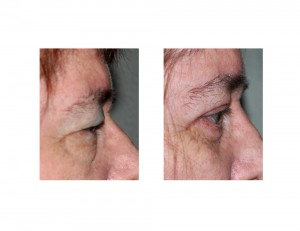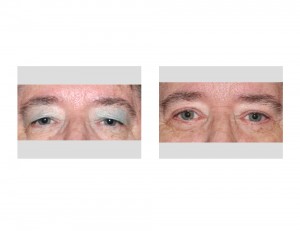Background: Changes around the eyes are the earliest signs of facial aging. As a result, the ongoing aging effects often creates severe changes around the eyes as one enters their sixties. Besides the excess skin of the upper eyelids and the lower eyelid bags, the eyebrows often sag downward magnifying the hooding effect on the upper eyelids.
Hooding of upper eyelid skin and brow sagging do have functional effects. By weighing down the upper eyelids there is a loss of a portion of one’s visual fields. A portion or all of the upper visual field may be lost as the position of the upper eyelid acts like a blind over a window. Partial closure of the blind results in loss of one’s ability to see what lies above as one is looking straight forward. This is often confirmed by an historic test known as Goldman’s visual field examination which evaluates the entire range of peripheral vision. But automated perimetry testing today has replaced the traditional Goldman method in many ophthalmology/optometry practices.
To correct these severe eye aging effects and to improve one’s upper peripheral vision, multiple procedures need to be done. With brow sagging, an upper blepharoplasty alone (while helpful) may induce one to remove too much upper eyelid skin and severely shorten the distance between the eyebrow and the lashline. (in essence even pulling the eyebrow down further) A browlift combined with an upper blepharoplasty is needed to not only lift up the low brows but to also reduce the amount of upper eyelid skin that really needs to be removed. Together they create a periorbital effect that is better than a browlift or an upper blepharoplasty alone.
Case Study: This 62 year-old female was bothered by the way her eyes looked and how ‘old’ her appearance. She had such severe hooding that her upper eyelid skin hung below her lashlines. The weight of her upper eyelids, combined with some brow sagging, created a pseudo ptosis look as the level of her upper eyelids enchroached on the iros of the eye.


Case Highlights:
1) Severe aging around the eyes results in brow sagging and upper eyelid hooding which does impact one’s superior visual fields.
2) Optimal correction of visual field obstruction requires a combined brow lift and upper blepharoplasties.
3) Lower blepharoplasties are often done at the same time to enhance the overall periorbital aesthetic effect but do not provide an improvement in peripheral vision.
Dr. Barry Eppley
Indianapolis, Indiana



